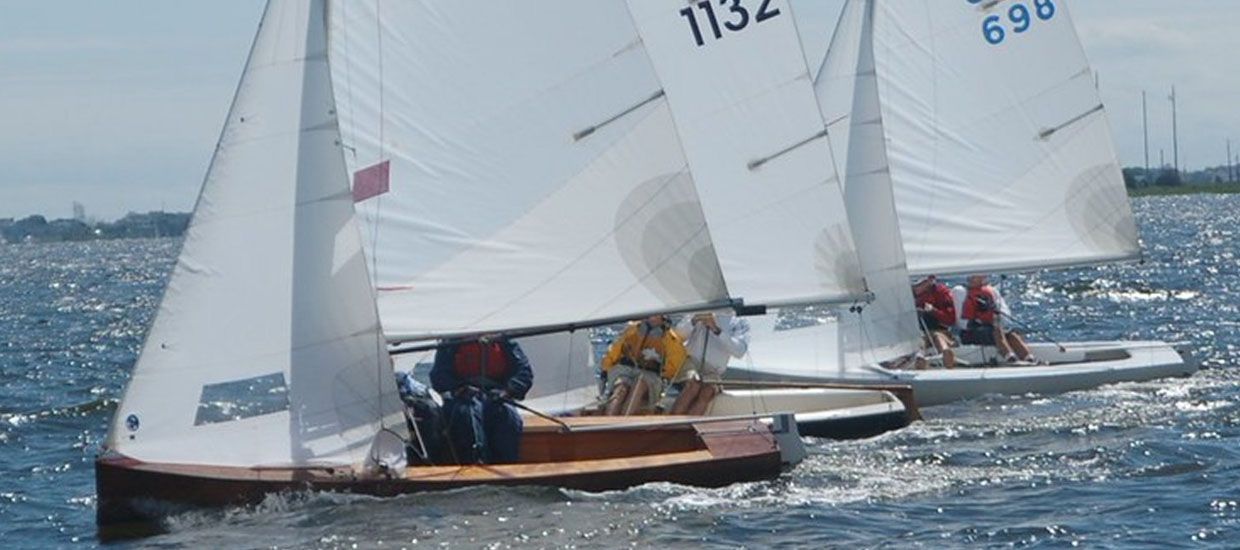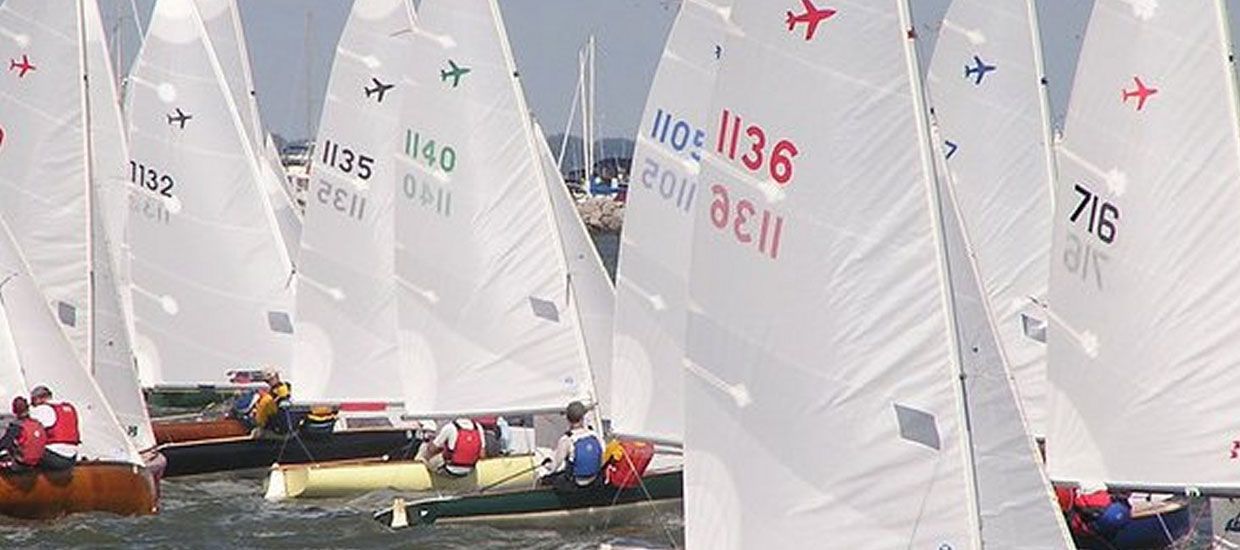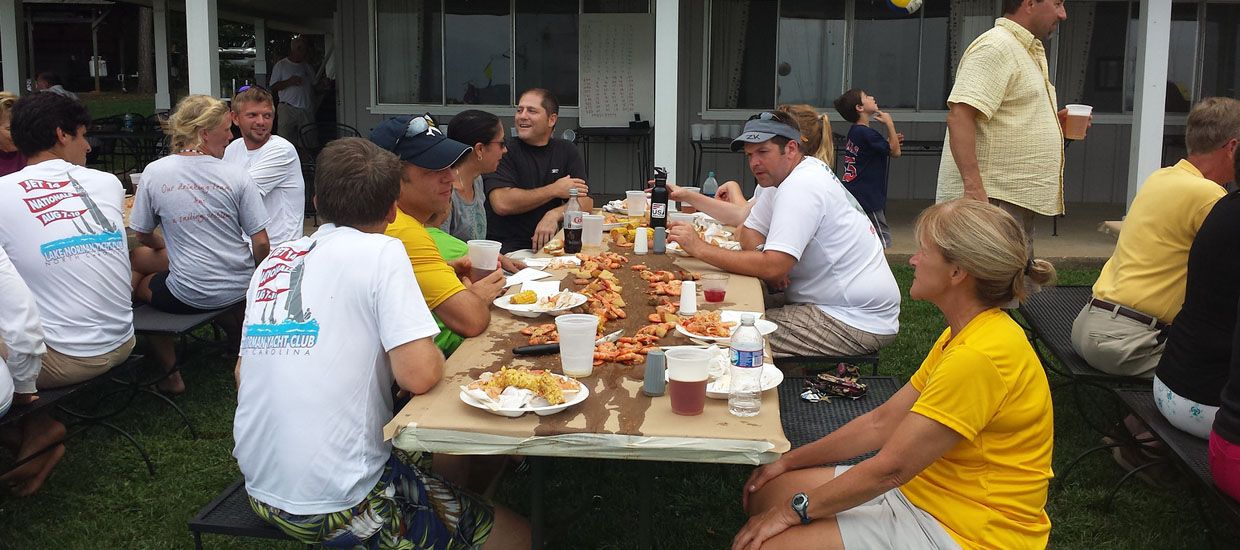Upwind: Waves, Wake and Flat Water August 12, 2003 Pre 2003 Nationals Seminar J. Dirk Schwenk
Author’s note: This is the handout from a pre-regatta seminar at the 2003 Nationals. It has been updated with a few pictures from that regatta. It is close to everything that is in this author’s head that relates to the technique of sailing jets up wind, particularly in waves. In my estimation, technique matters more than tactics, strategy, sail trim (other than sheet trim), and tuning combined.
1. The Rhett Simonds Minimalist Philosophy of Waves and Wake:
When I bought Fang in 1995, Rhett and Celeste Simonds were the absolute, unchallenged Chesapeake kings of heavy weather and big wake sailing. Rhett was always willing to help with tuning or sailing ideas, but he was not one to belabor a point. Since he regularly beat us in conditions where there were either significant wind-driven waves, or significant pleasure-boat chop, I would often ask him about how to improve those areas. Over the course of about five years he told me the whole story, in the inimitable Rhett style. His words:
a. What to do in a blow? “Sail flat.”
b. What to do in wake? “Play the sheets.”
2. The Dirk Schwenk Refinements of the Rhett Simonds Minimalist Philosophy of Waves and Wake:
Since those days, Stef and I have been blessed with the opportunity to sail regularly on summer weekends out of SSA. This provides the opportunity to learn more about speed through wave chaos than perhaps any other venue in the United States. After a lot of thinking, I am not sure that I can improve upon Rhett’s rules. I will add a little, however, and suggest some further refinements. Dirk’s rules:
a. Don’t steer with the rudder. (the rudder is not for steering, it is there to tell you whether your boat is balanced – steer with your weight and with your sails – see Rhett’s Rules).
b. Keep the boat dry.
3. The Groove:
If you put the three rules above together (aside from keeping the boat dry) you are really talking about sailing in the groove. In order to be fast in waves, you have to first sail in the groove, then modify things to respond to the waves. When it is all working right, here is what the groove feels like:
a. The boat is so flat that the only “feel” on the rudder is that of the waves wiggling the tiller as they pass under the boat
b. If the tiller starts to load up at all, hike a little flatter and ease the main an inch. Stay flat and trim back in. If you can’t stay flat and trim in, start depowering with vang.
c. To head up and follow a lift, let about 2 degrees of leeward heel in, and harden up on the main about two clicks on the ratchet. Trim the jib just a little slower, so it does not pull the bow down. Retrim for straight sailing.
d. If I need to head down to follow a header, I heel to windward about 3 degrees, ease the main an inch or two, and (if needed) trim the jib in two clicks until the bow comes down. Jib trim for steering is especially crucial in underpowered conditions. If you don’t believe me, pull the rudder out and sail around in five knots.
e. If the boat feels slow, I ease the main, use the jib and weight to pull the bow down, ease the jib two clicks, and speed back up. Once up to speed, jib comes in a click at a time. Repeat until exhausted.
The feel of all of this is a little different when it is very windy, but not much. In order to maintain groove as the wind comes up, pull the vang down (this settles the boat), but don’t forget to ease it as soon as there is a lull. Aside from the sheets and your body weight, the vang is the most important control. If the boat feels too quiet, ease it. If it feels out-of-control or overpowered, tension it. If you feel like you are bobbing in place – ease it, the jib and the mainsheet, get the boat started, then retrim.
4. Reacting to Waves in General;
a. Rule 1: Stay in the groove – see above.
b. Rule 2: Keep the boat dry. Whatever else you are doing, you will do it slower with 50 pounds of water in the boat.
i. Slide the crew at least two feet back from the side stay.
ii. Whenever there is a big nasty wave on the bow, roll crew and skipper weight back onto their back thigh to pull the bow up.
iii. If there is a breaking wave, skipper slide back as far as necessary, even to the transom.
iv. If there is a breaking wave, it may help to briefly heel the boat so that the water runs off the side of the deck, instead of into the cockpit. (This also gives the opportunity to reaccelerate by hiking the boat flat).
v. In really wet conditions, open the bailers upwind and down.
c. Rule 3: Trim for the conditions.
i. What kind of waves are you looking at? There are three basic wave types:
1. Swells: Big, organized, fast moving, far apart and repetitive. We only see these on the Chesapeake if we are on the open bay and it has been blowing out of either the North or the South for an extended period of time. What to do? Beats me. I never see them. I would try sailing upwind, finding their rhythm, and modifying my trim and hike to keep the boat balanced given the different winds at the top and bottom of the wave.
2. Wind-driven chop: This is what you get when the breeze is up for a couple of hours, and when you are in enclosed sailing area. The distance between the wave crests is short and the faces are steep. Pointers:
a. Slide back and keep the boat dry
b. Pull on vang to induce “flexible” rig.
c. Stay in the Groove.
d. If waves get big, consider easing traveler an inch or two to keep the boat moving.
3. Chaotic Waves
a. There are two phenomena that typically cause chaotic waves on the Chesapeake. Pleasure boats and fixed seawalls like the one in front of the NavalAcademy. The result – waves that come from directions that are not related to the wind, creating random peaks, valleys, and rogue waves. Other boats are the biggest issue.
b. Basic Response: same as for chop, with a flexible rig and plenty of play in the sheets. Tricky stuff discussed below.
d. Rule 4: Plan for the Conditions
i. Where we sail, there are often different kinds of waves at different points on the course. Often these follow predictable patterns, and their response can be planned in advance.
1. Typical West River 1 (Northerly): Wind driven chop at the start; chaotic waves as the channel is approached and crossed; flatter water, shiftier breeze, under shore at upwind mark.
a. Response: flexible, powerful chop rig for start; wake response mode for the channel; flat water settings (ease vang) for the top third. Try to stay in the middle of course by the mark, because you will need to be able to respond to the shiftiness caused by the land. If its really puffy near the mark, the flexible rig helps with this too.
2. Typical West River 2 (Southerly/South Easterly inside the point): Pretty flat at the start, channel running on left side of the course up to the windward mark; nasty, lumpy at the mark.
a. Response: Flat water point mode once speed is achieved off the line; monitor whether left (typically more breeze, but worse chop) or right (typically less breeze flatter water) seems to be paying off; leave lots of room and flexibility up near the mark so that you don’t get stuck in a wake and a crowd of boats. Overstand if necessary: don’t tack twice. Left pays more often than one might expect despite chop.
3. Typical West River 3 (Any breeze during the week)
a. Forget about the wake, since there is little pleasure boat activity, and focus on wind-driven wave patterns. Respond to wake if it arrives.
e. Rule 5: Straight Leg Hike:
i. Say what you want, but you can’t droop hike, sail flat, and keep from dragging your bottom in the wave crests. Also, when you are droop hiking, there is no way to slide back to respond to a wave on the bow. Something has to give, and I have given up droop hiking. When you can’t take the pain anymore, lengthen your hiking straps so that your heels extend in over the centerboard trunk, and slide your butt in a little.
5. Wake Response Mode:
a. Boat Set Up: Flexible Rig, with lots of sheet action, and follow the general wave pointers like keeping the boat moving and dry.
b. Brain Set Up: If you really want to be fast, repeat this 50,000 times: “Big power boats are my friend.” In the end, boat wake is just like wind shifts or tide – they are a factors to be considered in trying to get your boat around the course more quickly than your competitors. Everyone faces a similar challenge. The plus with boat wake is that you can often see it coming from a long way away, and you can see the boats that are making it long before you experience the wake. This gives you a chance to use the wake for your gain. Some things to consider:
i. If there is a boat a long way off than is going to come near, you may be able to tack now and encourage it to go behind you but in front of your competitors. Sailboats can be hailed and guided.
ii. If there is someone covering you that you want to get away from, you may be able to sail them into the wake, then tack away, leaving them with the choice of tacking through the wake twice, or giving you separation;
iii. You can decide whether to sail through or tack around a wake set, depending on what else is going on in the race. If you sail through, you may be able to surf out the other side. If you think you want to tack, don’t forget that power boats eat the breeze too, and you may be better off punching through to the upwind side of the wake.
iv. NEVER tack in the flat part of the wake immediately behind a power boat. The water is chopped up, and won’t give your blades any resistance, and the wind has been drastically disturbed You will go sideways. Get out of that area as soon as possible.
c. Technique: When you are dealing with a constant wake, like you get during the summer in Annapolis, you have to do what it takes to keep the boat moving. This includes steering up or down to avoid waves, easing and trimming sheets as appropriate, and heeling and hiking to get the boat to reaccelerate. Anticipate imminent big waves by heading off and easing the sheets. You must ease the main sheet to keep the upper leach from driving the bow down into the waves.
d. Upwind Surfing: When you are dealing with wake, you are as likely to have a big wave on your transom as you are to have one on your bow. There are times that you can surf these waves for dramatic gains. Be careful, though, because if the wave is not aligned properly, it may make you pinch or drive off too much. I find that it is easier to initiate a surf with a quick hike to unload the helm and significant ease of the main (I have no idea why this helps, but it seems to). Remember that pumping is not allowed under the rules to initiate a surf when going upwind.
6. Key Terminology:
a. Flexible Rig: I stole this from Stewart Walker’s Sail Trim book. It indicates additional twist in the sails, and on Jets mostly means easing the main and jib sheets a bit, sliding the jib car back (maybe), a little additional Cunningham (maybe) and putting the vang on (definitely). The theory is that more twist means that 1) something will be trimmed right when the boat is shaking around; and 2) when the bow starts down, the upper parts of the sails will luff instead of powering up. I personally do not move my jib cars very often, but I probably should.
b. Wake Response Mode: The sail trim is Flexible Rig, but the skipper/crew are ready to respond to what they are actually faced with, including tacking to avoid wake, trimming to induce upwind surfing, using wakes for picks against other boats, and easing the sails to punch through. In the great book High Performance Sailing (Bethwaite), he describes this mode as trying to sail the boat for the lowest available point on the water for the most amount of time.
c. Flat Water Mode: In flat water, the upper leaches of the main and jib can be trimmed much harder, and it may be possible to develop some additional lift off the rudder with a little heel. Pointing becomes paramount, and maintaining momentum is less of an issue. In terms of controls – vang off, traveler up, and minimum appropriate Cunningham on both main and jib. I still sail flat – others disagree.
d. Straight Leg Hiking: Hiking with your legs (and torso when you need it) are straight and parallel with the water. Your butt should be more or less the same level as the gunwale. Contrasts Droop Hiking, where legs are bent at the knees, and the butt is lower than the gunwale.
7. Final Thoughts: Except for keeping the boat dry, most everything between this sentence and Rhett’s rules is fluff. If you sail flat and play your sheets, you won’t need to steer with your rudder, and your helm will tell you when the boat is out of balance with weight or sail trim.
8. Postscript: some photos from the event:
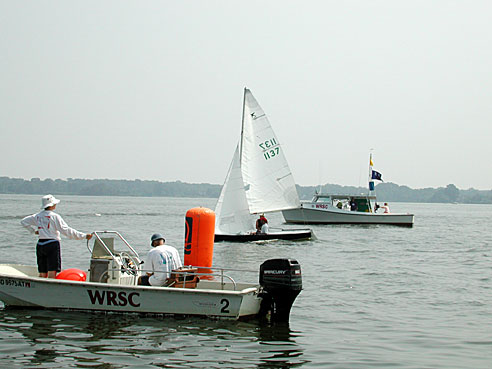
Peter Jones Photograph
Two days after this seminar was given, the author at the 2003 Nationals on the West River. Breeze is under 5 knots. Note that the bow has just dropped into the trough on the back side of a wake, and the upper half of the main is luffing. This indicates that the sheets are not over trimmed, and that there is a good deal of twist in the main. It is very important that the upper main not load up as the bow drops, as this will drive the bow in deeper. Of course, you don’t want the upper main luffing too much, so this is very much a balance. I typically ease main an inch or so when the bow starts up. Also good -- Crew weight perfectly together fore and aft, boat near flat, crew’s weight low in the boat, tiller extension held in front of chest (not “frying pan” style), and sailing in clear air.

Peter Jones Photograph
Brent Barbehenn, winner of the event, on the same day. Note that breeze is slightly up (see flags on committee boat), and that waves are perfectly flat. The main sheet has been tightened (so that the upper batten is parallel to the boom, or perhaps just slightly to windward), Brent has slid his butt over the rail, his crew is leaning to windward without disturbing Brent or the hull with unnecessary movement of his feet or butt, the boat is within a degree or two of being flat, and Brent’s tiller extension and mainsheet are together in front of his chest so that he can feel and trim both simultaneously.
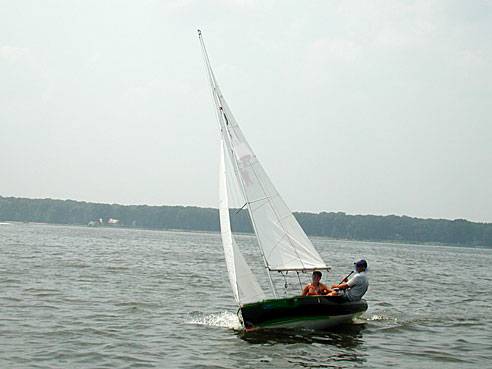
Peter Jones Photograph
Same day, same conditions, different technique, different result. With approximately 15 degrees of heel, there is heavy wash coming off the rudder. You can sense the boat moving sideways with the heel and rudder load. The author has obscured the identity of this boat, but its overall finish was in the mid-twenties. A few thoughts: good technique would have main and jib sheets eased as soon as puff hits, and the crew immediately moving to the rail so that there is never any heel. Best technique would have the crew sensing the coming puff, and moving to the rail to meet it, so that no power would need to be lost to unnecessary easing or heeling. Also, better helm technique would be to have both the mainsheet and tiller extension held with bent elbows right in front of the chest. This looks suspiciously like the mainsheet is cleated and the tiller extension is gripped with a full fist. These techniques make it impossible to feel what the sheet and tiller are telling you, and makes it impossible to rapidly respond if you notice the pressure. One way to develop improved feel is to sail with just one finger and the thumb loosely on the tiller extension, instead of a full fist grip. With hands together in front, one can use the tiller hand to help with the mainsheet, instead of the cleat. Cleats should never be used upwind. To develop helm feel, try practicing with the tiller held just between two fingers, like a cigarette, so that there is no temptation to clutch the extension. If that feels insecure, there is too much rudder load.
